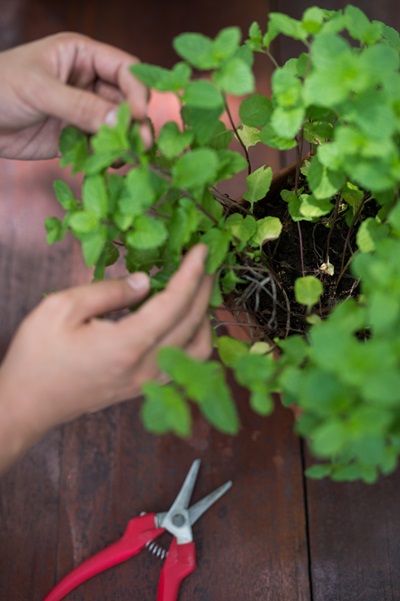DIY Remedies for the Home Garden

Published on
01 Apr 2020
Published by
My Green Space
Gardening at home can be a very fun and fulfilling activity anyone can take part in, regardless of whether one has ‘green fingers’ or a flair for cultivating plants.
Pests and diseases, however, can pose significant problems to seasoned and first-time gardeners alike. Instead of reaching for that bottle of pesticide which has toxins that can cause undesirable impacts to both humans and plants, there are many safer homemade remedies which you can use. On top of the more well-known garlic and chilli sprays, read on for some DIY home remedies for your garden.

Gardening is a great activity all can take part in – all you need is a pot, some soil and of course, your plant! Photo credit: NParks
Soaps

Sulphur Soap. Photo credit: Dr Wilson Wong
Soaps are often cited as a great form of pest control. Generally, soaps work by suffocating insects they come into contact with and dissolving their exoskeletons, which leaves them liable to drying out. They are especially effective against most small, sap-sucking pests like aphids, mealy bugs, mites and scale insects, and are much less harmful compared to conventional pesticides, being safe on skin and easily washed away by rainwater.
Types of soaps that can be used in the garden
- Castile soap
A potassium-based soap made from vegetable oils, this liquid soap is easily dissolved in water, and the potassium present serves as nutrients for plants too. A common dosage to start off with is a teaspoon of castile soap to a litre of water. - Sulphur soap
Available in the form of solid bars, this type of soap can be used as a miticide. As it contains sulphur, it is effective in destroying mites, especially spider mites and broad mites. It is also effective against other sap-sucking pests. To use it, first grate the soap into flakes then dissolve a teaspoon of these in a small amount of hot water before topping up the mixture with tap water till it reaches a litre. It is vital to shake the solution well before applying it on plants.
Baking Powder

Baking powder. Photo credit: Dr Wilson Wong
If fungal diseases are more of a concern in your garden, you may consider trying baking powder. Consisting of sodium bicarbonate, which is an alkaline substance, baking powder is able to create pH conditions that act as a fungal disease preventative. Simply dissolve a teaspoon of baking soda in a litre of water, then apply the solution to both sides of leaves on your plant. Baking powder is known to be most effective in preventing the powdery mildew that commonly infect the leaves of the Lady’s Finger (Abelmoschus esculentus) and Cucumber (Cucumis sativus).
Milk
Similar to baking powder, milk also has fungicidal properties which can be used to keep powdery mildew away. This is because it contains substances that retard fungal growth and/or create conditions conducive for beneficial microbial growth that out-compete undesirable ones. At present, there is no consensus on the perfect ratio of milk to water, and this can range from a more concentrated two parts milk to three parts water to the very dilute one part milk to nine parts water.
Cinnamon powder

Cinnamon powder. Photo credit: Dr Wilson Wong
Cinnamon powder contains substances which makes it suitable for use as a fungicide in the garden. It can be applied to exposed plant parts such as those created when making stem cuttings, to protect them against fungal diseases.
Yeast

Yeast. Photo credit: Dr Wilson Wong
Snails and slugs can damage plants, especially during wet weather, and can be problematic to prevent as most commercially available molluscicides are also highly poisonous to pets, humans and other wildlife. Stale beer is often cited as an environmentally-friendly solution, though it involves buying a can of beer first, which can cost some money. Save the beer for yourself and opt for a cheaper alternative: yeast (also found in beer)!
You can make your own yeast bait by mixing one cup of water (approximately 250 ml), one teaspoon of sugar and 1/4 teaspoon of yeast. Pour this solution into a baking pan and bury it into the ground. Snails and slugs are attracted to the solution and will eventually drown in it.
Additional tips
- It is important is to select a plant species that is appropriate for a particular site, so as to prevent problems from emerging.
- Examine your plants daily and cut away infected leaves or remove pests found on them.
- Opt only to use chemical pesticides when the pest population or damage to the plant is high.
- As with conventional pesticides, with home remedies, always start with a test spray on a small part of the plant. If the spray is too strong, dilute the dosage before you spray it onto the entire plant.
- Apply these home remedies to plants during the cooler part of the day.
For more information on gardening, you may check out the many gardening tips on our website here.
Text by Dr Wilson Wong
Source: My Green Space @ NParks. Reproduced with permission.
ALL views, content, information and/or materials expressed / presented by any third party apart from Council For Third Age, belong strictly to such third party. Any such third party views, content, information and/or materials provided herein are for convenience and/or general information purposes only. Council For Third Age shall not be responsible nor liable for any injury, loss or damage whatsoever arising directly or indirectly howsoever in connection with or as a result of any person accessing or acting on any such views, content, information and/or materials. Such third party views, content, information and/or materials do not imply and shall not be construed as a representation, warranty, endorsement and/or verification by Council For Third Age in respect of such views, content, information and/or materials.







